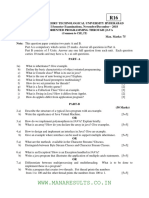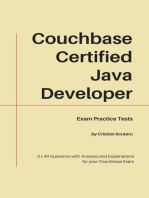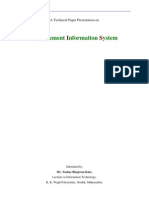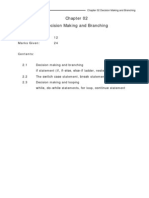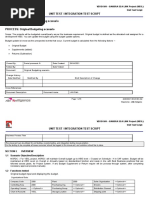0 ratings0% found this document useful (0 votes)
114 viewsSessional Test-I Core Java 2007-2008
This document is a sessional theory test for a Core Java class. It contains 3 questions testing students' knowledge of Core Java concepts. Question 1 has 6 short answer subquestions about bytecode, this keyword, garbage collection, nested/inner classes, wrapper classes, and String/array methods. Question 2 has 4 short answer subquestions about using Vector as a queue, javac and java commands, Long and Double class methods, and static vs final. Question 3 has 2 longer answer subquestions about Arrays class methods, return statement, post-test loop, and inverting a string's characters. The test has a total of 50 marks and is meant to be completed in 2 hours.
Uploaded by
api-3728136Copyright
© Attribution Non-Commercial (BY-NC)
Available Formats
Download as PDF, TXT or read online on Scribd
0 ratings0% found this document useful (0 votes)
114 viewsSessional Test-I Core Java 2007-2008
This document is a sessional theory test for a Core Java class. It contains 3 questions testing students' knowledge of Core Java concepts. Question 1 has 6 short answer subquestions about bytecode, this keyword, garbage collection, nested/inner classes, wrapper classes, and String/array methods. Question 2 has 4 short answer subquestions about using Vector as a queue, javac and java commands, Long and Double class methods, and static vs final. Question 3 has 2 longer answer subquestions about Arrays class methods, return statement, post-test loop, and inverting a string's characters. The test has a total of 50 marks and is meant to be completed in 2 hours.
Uploaded by
api-3728136Copyright
© Attribution Non-Commercial (BY-NC)
Available Formats
Download as PDF, TXT or read online on Scribd
You are on page 1/ 1
K. K. WAGH POLYTECHNIC, NASHIK - 3.
DEPARTMENT OF COMPUTER TECHNOLOGY.
SESSIONAL THEORY TEST- 1 (OCT 2007)
CLASS: TYCM. TIME: 2 Hrs.
SUB: CORE JAVA (CJV - 1524) MARKS: 50.
= = = = = = = = = = = = = = = = = = = = = = = = = = == = = = = =
Instructions:-
1) All questions are compulsory.
2) Illustrate your answers with neat sketches wherever necessary.
3) Use of Non programmable Electronics Calculator is permissible.
4) Figures to the right indicate full marks.
5) Assume suitable additional data, if necessary.
Q.1 Attempt any SIX of the following: 18
a) Explain: bytecode and Java Virtual Machine.
b) Explain the use of this keyword with proper example.
c) Describe garbage collection performed in Java.
d) Explain concept of nested and inner classes with suitable
example.
e) Explain any four Byte wrapper class methods.
f) What is the use of new operator and boolean data type?
g) Explain the application of trim(), length() methods of String
class and length attribute for arrays.
h) Describe differences between protected and private access.
Q.2 Attempt any FOUR of the following: 16
a) Explain how Vector is used as a queue?
b) Explain the statements: javac prog.java
java prog 45 12 23
c) Give and explain syntax of any two Long as well as Double class
methods.
d) Describe the differences between static and final.
e) Write a program to find the entered number is prime or not? Your
program must use command – line arguments.
f) Describe the functions performed by javap, javah, javadoc and
jdb.
Q.3 Attempt any TWO of the following: 16
a) Describe in detail.
i) Arrays class methods ii) indexOf()method
iii) return statement iv) Post-test loop
b) Write a program to accept the string from user and invert each of
character of the string. e.g. input = “AbCdE” output = “aBcDe”.
c) Explain: why Java is superior to other programming languages?
*ALL THE BEST *
You might also like
- WWW - Manaresults.Co - In: (Common To CSE, IT)No ratings yetWWW - Manaresults.Co - In: (Common To CSE, IT)2 pages
- ICSE Class 10 Computer Applications (Java) 2011 Solved Question Paper - ICSE J0% (1)ICSE Class 10 Computer Applications (Java) 2011 Solved Question Paper - ICSE J10 pages
- CMS PRE-BOARD Question paper Class 10th ComputerNo ratings yetCMS PRE-BOARD Question paper Class 10th Computer9 pages
- ICSE COMPUTER APPLICATIONS CLASS 10 Important Questions100% (1)ICSE COMPUTER APPLICATIONS CLASS 10 Important Questions24 pages
- Java Programming Sample Paper 5th Semester MSBTE Diploma100% (7)Java Programming Sample Paper 5th Semester MSBTE Diploma2 pages
- Advance Java Vtu Previous Year Question Paper0% (1)Advance Java Vtu Previous Year Question Paper2 pages
- Question Bank: Programming in C' (9017) Class: FYIF Chapter No. 05 PointersNo ratings yetQuestion Bank: Programming in C' (9017) Class: FYIF Chapter No. 05 Pointers2 pages
- CPR Notes - Chapter 02 Decision Making and Branching0% (1)CPR Notes - Chapter 02 Decision Making and Branching24 pages
- Program 2.23 Calling Sequence of ConstructorsNo ratings yetProgram 2.23 Calling Sequence of Constructors4 pages
- Program 2.16 Defining A Class Inside A MethodNo ratings yetProgram 2.16 Defining A Class Inside A Method5 pages
- Multi-Tenant Saas Applications: Maintenance Dream or Nightmare?No ratings yetMulti-Tenant Saas Applications: Maintenance Dream or Nightmare?5 pages
- Types of Software Testing Powerpoint PresentationNo ratings yetTypes of Software Testing Powerpoint Presentation52 pages
- Sil At-Pt&sb 968 - V - 1054 - 05 - 23 2024No ratings yetSil At-Pt&sb 968 - V - 1054 - 05 - 23 20243 pages
- Unit Test / Integration Test Script TEST SCRIPT: Original Budgeting Scenario Module: Ps PROCESS: Original Budgeting ScenarioNo ratings yetUnit Test / Integration Test Script TEST SCRIPT: Original Budgeting Scenario Module: Ps PROCESS: Original Budgeting Scenario6 pages
- Software Requirements Modeling and Design: CS/SWE 321 Dr. Rob Pettit Fall 2014No ratings yetSoftware Requirements Modeling and Design: CS/SWE 321 Dr. Rob Pettit Fall 201459 pages
- CTC-601 - Lexis - LEAP ENGINES - Sep 15 - (USB CD Lexis Version Only)100% (4)CTC-601 - Lexis - LEAP ENGINES - Sep 15 - (USB CD Lexis Version Only)9 pages
- Agile PDF - Fundamentals Requirements ManagementNo ratings yetAgile PDF - Fundamentals Requirements Management4 pages
- Marine Engine L32/40 Series: General SpecificationsNo ratings yetMarine Engine L32/40 Series: General Specifications1 page

















